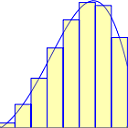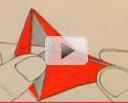Intmath Newsletter - resources, summation, Riemann, census
By Murray Bourne, 22 Jun 2010
22 Jun 2010
In this Newsletter:
1. Latest feedback on IntMath
2. Resource - free online math calculators
3. Math tip: Summation notation
4. Math tip: Riemann Sums
5. Friday math movie: Tribute to Martin Gardner
6. 2010 Census in USA and Singapore
7. Final thought – looking for new skills
1. Latest feedback on IntMath
(a) IntMath was named an "excellent Twitterer" in the BestNursing.net article "50 Excellent Twitterers Providing Daily Learning & Study Tips". [no longer available.]
You can follow Intmath on Twitter.
(b) Reader J. Venkata Ramana (from India) enthusiastically wrote this about IntMath.com:
O! Great Guruji! I bow to you. A very astonishing, surprising way of teaching Mathematics with ease.
When one visits your site the content gets recorded in the mind. They cannot forget. This is a great job!
("Guruji" means "revered teacher". I'm blushing...)
It's always nice to hear how IntMath helps people.
2. Resource - free online math calculators
Here is an interesting collection of free calculators. You can choose from 18 different calculators, including ones that draw graphs, some that help with algebra and there's even a fraction calculator.
When you get there, you can choose the different calculators using tabs at the top of the page that look like this:
Here's the link: Online math calculators
3. Math tip: Summation
Suitable for: Everyone! You will all come across summation notation at some stage.
|
In this dialog, Yousuf has trouble understanding a question involving summation notation. After some effort, he gets there! This is quite a long post, but it is worth following it all the way through. Read more: Summation Notation |
3. Riemann Sums
Suitable for: This article introduces some important concepts in calculus. Even if you are not at that level yet, you will still get something from playing around with the graphs.
 |
In this article, you can investigate the area under a curve using an interactive graph. This demonstrates Riemann Sums. Mathematicians worked very hard to crack this problem, starting with the ancient Greeks and culminating in the work of Newton and Leibniz in the late 17th century. Learn more: Riemann Sums |
4. Friday math movie - Martin Gardner
Suitable for: Everyone.
 |
Martin Gardner, who wrote widely on recreational mathematics for Scientific American magazine, died in May 2010. Here is an interesting one-hour TV special that features Gardner. Watch the video: |
5. 2010 Census
Suitable for: Everyone.
 |
The census is going on right now in the US, and in Singapore too. So you think counting is simple? Whenever there is statistics about people, it is never straightforward. The decennial (once every 10 years) Census gives an interesting snapshot on population and culture throughout time. The questions continually evolve and that’s what makes it interesting. Read more: 2010 Census |
6. Final thought – looking for new skills
Author, keynote lecturer and productivity consultant Denis Waitley has the following to say about learning, and it is quite relevant during the long summer holiday months:
All of the top achievers I know are life-long learners, looking for new skills, insights, and ideas. If they're not learning, they're not growing, and not moving toward excellence.
Denis Waitley
Since it is now the summer holidays in most of the Northern hemisphere, you may be interested to read an article I wrote a few summers ago, The Summer Math Brain Drain. How will you spend your summer?
Until next time, enjoy whatever you learn.
See the 4 Comments below.

